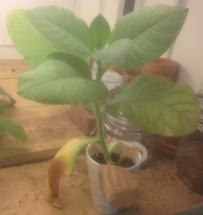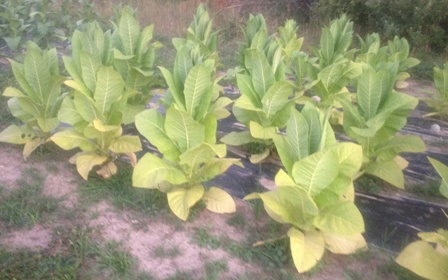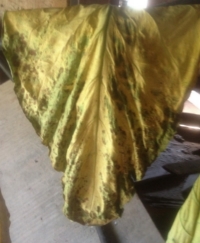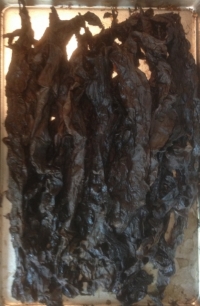U-235
Well-known member
- Joined
- Oct 29, 2013
- Messages
- 65
- Reaction score
- 0
Briar Spirit, I would be more than glad to answer your questions. If you don't have the means of growing tobacco, you can always order raw tobacco, known as "whole leaf tobacco" online (www.leafonly.com and wholeleaftobacco.com). I used to order from them to practice processing techniques while I was experimenting with growing and air curing tobacco. The nice thing about working with whole leaf tobacco is that the Federal Tobacco Tax Bureau (TTB) does not require a license or permit to buy or sell it - additionally, the are no federal excise taxes imposed. But once you modify the whole leaf in any way, even by removing the midstem or cutting it, then the modified whole leaf tobacco is considered a "tobacco product" and it is subject to the same laws and tax regulations as all other tobacco products. Beware: the TTB and ATF are very strict in upholding their definition of whole leaf tobacco.Briar Spirit":ybgxdgox said:Now that right there is most interesting, my late Da' used to grow and produce his own tobacco and that was all he ever smoked, wish I'd known him longer so I could have learnt more from him. I wonder, could I ask do you have any photo's of your tobacco producing you could share with us, I should dearly love to see any you might have. I've oft' wanted to grow my own tobacco myself but space restrictions and of course financial limitations stop me from doing so but seeing other folk getting along with it seems to fill that void. What sort of tobaccos do you grow, what treatments do you use, do you have specific blends you create, do you do rope/twist tobaccos, do you perchance do your own aromatics. Sorry, lots of questions there, the subject fascinates me I must say. :sunny:U-235":ybgxdgox said:I grow and process my own tobaccos. There are many tricks of the trade. It takes extensive amount of time and experimentation to transform a tobacco seed into a pleasurable smoke. Producing premium quality tobacco is truly an art and a science. :face:
In Michigan, the growing season is shorter than in the tobacco belt (Kentucky, Tennessee, etc.) so curing can be a little tricky. It took me a couple of years to get it right, but its works. If they can grow tobacco in Canada, then tobacco could be grown throughout most of the USA. Also, I don't use insecticides. I grow an excess amount - so if a plant is afflicted with any disease or manifestations (especially aphids), I simple pull the plant out from the roots and put it in the fire. But fortunately, this has not been a major problem. Fortunately, the land on which I grow the tobacco is ideal. (You can have your soil tested - it's very simple.) So I have not had to use any fertilizers. I posted some pictures below.
Once you have the cured raw "whole leaf tobacco," then you can apply a whole variety of processing techniques. Many of these techniques depend on the variety of tobacco. I started out with making cigarette tobacco because it is the easiest to process (toasting at 200 to 230 degrees F). Cigar leaf and Virginias are kiln-fermented for about a month. Then I moved onto to making pipe blends. My preferred method is to process each leaf component individually and then press all the variously (processed) leaves together from 2 weeks to 1 year. When I want to smoke my tobacco, I slice a piece from the plug, rub it out, let the tobacco air dry for 30 min to an hour, stuff it into my pipe, and enjoy the fruits of my labor.
As far as tobaccos I use, I grow many types of almost each main variety: Burleys, Virginias, Orientals, Cigar leaf, Rusticas, and Dark Air. I make all kinds of blends that I cannot categorize as traditional VaPers, English/Balkan, Burleys, etc. I purchase many of these blends already prepared. I do not try to imitate what is available on the market. I use my creativity to blend something unique. Like I said, there is a lot of time and experimenting involved. Sometimes (or many times) a blend just doesn't workout, but when I get one to work, it is very rewarding. I prefer stout blends just as a beer drinker likes Guinness. So I focus on Burleys and Dark Air varieties. These varieties are actually the harder varieties to color cure in Michigan as it takes at least 2 months to cure.
All in all, I could fill several pages with words on this forum with information about how to produce your own tobaccos; for the forum's sake I will not use up all of its storage capacity. However, if you still have any more questions, please feel free to send me a PM. I enjoy sharing my experiences with this "hobby" to others. 8)
1. Here is a picture of a seedling of a Cigar leaf variety (Florida Sumatra) ready to transplant to the field. Note how large is this seedling. With a shortened growing period in Michigan, my seedlings are extra large in order to get a head start.

2. Here is a picture of some Virginia youngsters (Yellow Orinoco)

3. Here is a picture of Tennessee Burley ready to harvest. Note the yellowing on the lower leaves.

4. Here is a picture of a leaf of a Virginia after one week of air-curing (Yellow Orinoco)

5. Here is a picture of a (steamed) Virginia black cavendish (Hickory Pryor)

